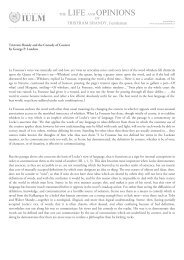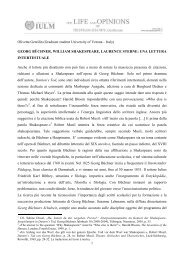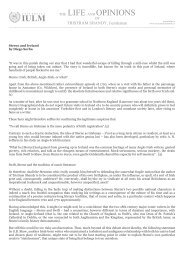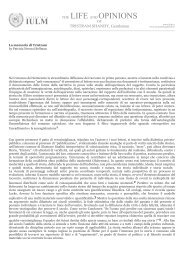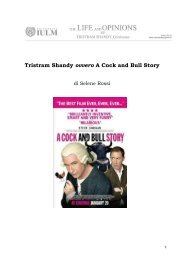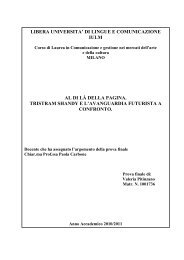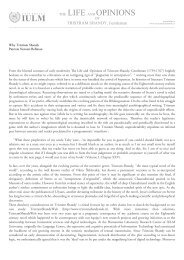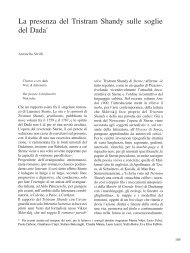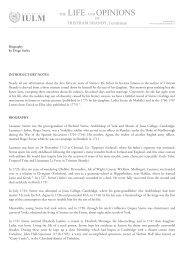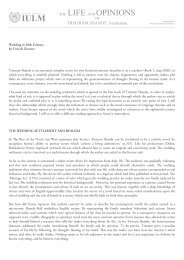St Michael's Church COXWOLD - The Tristram Shandy Web
St Michael's Church COXWOLD - The Tristram Shandy Web
St Michael's Church COXWOLD - The Tristram Shandy Web
You also want an ePaper? Increase the reach of your titles
YUMPU automatically turns print PDFs into web optimized ePapers that Google loves.
<strong>St</strong> <strong>Michael's</strong> <strong>Church</strong><br />
<strong>COXWOLD</strong>
In the beginning..<br />
When Christianity came to England, the<br />
sites of pagan temples which were<br />
converted to churches were often<br />
dedicated to <strong>St</strong> Michael and all Angels,<br />
presumably to ensure the old gods<br />
were outnumbered. <strong>The</strong>re is no doubt<br />
that <strong>St</strong> <strong>Michael's</strong> <strong>Church</strong>, Coxwold, was<br />
one of the first churches in Yorkshire<br />
and is probably built on the site of a<br />
pagan temple.<br />
<strong>The</strong> people of Northumbria were<br />
converted to Christianity in 627 AD<br />
when <strong>St</strong> Paulinus visited King Edwin<br />
who lived near York, probably at<br />
Topcliffe. <strong>The</strong> story is told by 'the<br />
Venerable Bede writing in 731 AD.<br />
When the King had heard Paulinus<br />
preach he consulted his nobles, one of<br />
whom said: "<strong>The</strong> life of man, O King,<br />
compared with the time of which we<br />
know not, is like the flight of a sparrow<br />
through this ball. <strong>The</strong>re you sit at meat<br />
with your chieftains and servants in<br />
Winter time, with a fire blazing in the<br />
midst and raia and stonn blustering<br />
outside, and in it flies through one door<br />
and out of the other. While it is inside it<br />
is not touched by the winter storm,<br />
after a little while of calm it vanishes<br />
from sight into the winter again. Thus<br />
we see the life of man for a span, but<br />
what carne before or after we know not.<br />
If the New Teaching brings sure<br />
knowledge of the after life we must<br />
follow it."<br />
King Edwin then ordered all his tribe<br />
to be baptised by Paulinus in the River<br />
Swale. <strong>The</strong> Venerable Bede tells how<br />
Coifi, the ex-pagan chief priest,<br />
mounted on a stallion with sword<br />
girded and grasping a lance, rode off to<br />
destroy the shrine and idols. I like to<br />
think it might have been to Coxwold<br />
that Coifi rode.<br />
<strong>The</strong> first positive mention of a church<br />
at Coxwold is in a letter from Pope Paul<br />
1, dated 757 AD, telling ‘King Eadbert of<br />
Northumbria to repair three Minsters,<br />
those at York, Ripon and Coxwold. We<br />
<strong>St</strong> <strong>Michael's</strong> <strong>Church</strong>, Coxwold<br />
3<br />
can assume from this that there was a<br />
Saxon centre of Christian worship here<br />
from about 700 AD, also a Saxon Manor<br />
and Parish.<br />
Records do not report if King Eadbert<br />
carried out repairs but the Saxon<br />
building was replaced by a Norman<br />
one during the late llth century. This<br />
Norman church was in its turn replaced<br />
by the present "perpendicular style"<br />
church which was built between 1420<br />
and 1430. Except for minor repairs this<br />
church still stands as it was built.<br />
Looking down the nave you will see<br />
the Royal Coat of Arms of King George<br />
II over the chancel arch which divides<br />
the main body of the church from the<br />
narrower chancel. <strong>The</strong> Royal Arms<br />
were first used in churches at the time<br />
of King Henry VIII to remind everyone<br />
that the English monarch rather than<br />
the Pope was now the authority<br />
responsible for seeing that the <strong>Church</strong>'s<br />
laws were obeyed.<br />
On either side are the armorial<br />
bearings of the Earls of Fauconberg,<br />
with the motto being a pun on the<br />
family name of Belasyse:<br />
et Belle Assez" (To be good and beautiful<br />
is enough).<br />
<strong>The</strong> Royal Coat of Arms is that used<br />
from the accession to the throne of the<br />
Hanovers in 1714 until the lapse of the<br />
claim by the English king to the throne<br />
of France in 1801. <strong>The</strong> four quarters are<br />
the leopards of England and the lion of<br />
Scotland side by side, the fleur de lys of<br />
France, the harp of Ireland, and lastly a<br />
composition of the devices of Hanover,
Luneberg and Westphalia with the<br />
crown of Charlemagne in the centre.<br />
<strong>The</strong> magnificent nave ceiling, which<br />
is unusually wide, is made of oak. It is<br />
the<br />
origina<br />
l ceiling<br />
and still<br />
looks<br />
very<br />
much as<br />
it did<br />
when<br />
built in<br />
1420.<br />
Some<br />
woodwork<br />
has had<br />
to be<br />
Detail from a roof boss —<br />
a grotesque<br />
<strong>St</strong> <strong>Michael's</strong> <strong>Church</strong>, Coxwold<br />
renewed<br />
and the<br />
bosses repainted. <strong>The</strong> bosses —<br />
decorative plaques at the intersection of<br />
the roof beams — include the amorial<br />
bearings of families prominent in the<br />
county of Yorkshire in the early 15th<br />
century: they include those of the Percys,<br />
Nevils, Mowbrays, Colvils and <strong>St</strong>utelys.<br />
In addition there are some<br />
grotesques, perhaps showing a certain<br />
disregard for the great<br />
families by the craftsmen<br />
of the day. In 1904 during<br />
restoration of the ceiling<br />
the shield of the arms of<br />
Wombwell quartering<br />
Belasyse was introduced<br />
over the Lady Chapel at<br />
the right of the nave.<br />
<strong>The</strong> windows at the<br />
north side of the nave are<br />
filled with stained glass.<br />
<strong>The</strong> glass in the tracery<br />
lights is very old. Some of<br />
it may be as much as 100<br />
years older than the<br />
building, coming from an<br />
earlier Norman church.<br />
<strong>The</strong> larger panels —<br />
memorials to members of<br />
the Wombwell family —<br />
are of Victorian glass, not<br />
to everyone's taste but the<br />
very best of its type. Also<br />
on the north wall<br />
are memorials to the two soldier sons of<br />
Sir George and Lady Wombwell.<br />
At the west end of the nave there is a<br />
gallery containing the organ. This is a<br />
new instrument installed in 1972 by<br />
<strong>Church</strong> & Sons. Until recent times the<br />
choir also had their seats in the gallery.<br />
At the back of the gallery are two<br />
diamond-shaped funereal hatchments<br />
of the Fauconberg arms, placed there<br />
after the deaths of members of the<br />
family. Below these hatchments can be<br />
seen black lettering which is just<br />
discernable as the Lord's Prayer. <strong>The</strong><br />
date of this lettering is not known.<br />
Under the gallery, just to the left of<br />
the vestry door, may be seen the<br />
signatures of Queen Mary, wife of King<br />
George V, together with those of<br />
Princess Mary, the Princess Royal, her<br />
husband the Earl of Harewood and<br />
members of their suite. <strong>The</strong>y visited the<br />
church while staying at Newburgh<br />
Priory as guests of Captain V.M.<br />
Wombwell.<br />
<strong>The</strong> pews are "box pews" and many<br />
still have locks dating from the time<br />
when each family in the village rented<br />
its own pew. Until 1906 the pew backs<br />
and sides were about 18 inches higher<br />
than at present. <strong>The</strong>y were reduced to<br />
<strong>The</strong> lectern, carved by Josef Heu, an Austrian sculptor<br />
who found refuge in Coxwold in 1941 after fleeing the<br />
Nazis
their present size by the<br />
joiners taking off wood<br />
from the bottom of the<br />
pews.<br />
At the same time the<br />
pulpit was reduced from<br />
being a "three decker" by<br />
the removal of the bottom<br />
deck. <strong>The</strong> original pews<br />
and pulpit were the idea<br />
of the parson at the time<br />
who was the author, the<br />
Reverend Laurence <strong>St</strong>erne,<br />
perhaps best known for<br />
his novel "<strong>Tristram</strong><br />
<strong>Shandy</strong>". <strong>The</strong>y were built<br />
while he was the<br />
incumbent during the<br />
period 1760-1768.<br />
In the floor of the aisle,<br />
as you approach the<br />
chancel arch, is a black<br />
slab with two brass plates.<br />
One of these<br />
records the death of Sir John Manston,<br />
who died in 1464. <strong>The</strong> name of his wife<br />
Elizabeth is added with a blank space for<br />
the date of her death. <strong>The</strong> date was never<br />
inserted, and as there is no parish record<br />
of burials before 1583 a mystery remains<br />
as to whether she was buried by the side<br />
of her husband.<br />
In the nave you will find four carvings<br />
of a little mouse, the trade mark of Robert<br />
Thompson, a well-known furniture<br />
maker whose family business is still in<br />
Kilburn, a neighbouring village. Two of<br />
these are in the Lady ChapeI, one being<br />
clearly visible under the ledge of the<br />
niche in the wall. <strong>The</strong> third mouse is on<br />
the lectern stand. <strong>The</strong> top of the lectern<br />
was carved by Josef Heu, a distinguished<br />
Austrian sculptor who found-refuge in<br />
Coxwold in 1941 alter fleeing from the<br />
Nazis.<br />
<strong>The</strong> fourth mouse is on the Bible case<br />
which contains a "Breeches Bible" socalled<br />
from the use of the word in verse 7,<br />
chapter 3 of Book of Genesis, which in<br />
modem versions is given as "loinclothes".<br />
It is more properly called the Geneva<br />
Bible. This Bible was printed in 1601 by<br />
Robert Barker, printer to Queen<br />
Elizabeth I.<br />
<strong>St</strong> <strong>Michael's</strong> <strong>Church</strong>, Coxwold<br />
<strong>The</strong> chancel, with its unusual horseshoe communion rail<br />
<strong>The</strong><br />
Chancel<br />
Four monuments dominate the chancel<br />
and they will be dealt with in detail<br />
later. <strong>The</strong> chancel was rebuilt in 1774 by<br />
Thomas Atkinson and it is probable<br />
that the unusual horse-shoe shaped<br />
altar rail was installed at this time. This<br />
delightful feature is in regular use at<br />
Communion and does give a sense of<br />
togetherness to the congregation.<br />
In the chancel is a framed list of<br />
priests who have ministered at<br />
Coxwold. For 400 years — from 1145<br />
until 1545 — the Prior of the Augustian<br />
Priory at Newburgh was responsible<br />
for the pastoral of the neighbourhood<br />
and the charge of the parish church of<br />
Coxwold. This means there was no<br />
specific vicar during this period.<br />
Also in the chancel are two framed<br />
lists of those members of the Parish<br />
who served their King and Country<br />
during the two World Wars. <strong>The</strong><br />
ancient sword fixed to the wall is said<br />
to be a Toledo blade, its provenance is<br />
unknown.
<strong>The</strong><br />
Lady Chapel<br />
<strong>The</strong> Lady Chapel is accurately so-called<br />
because it was so designated when the<br />
church was built. <strong>The</strong>re is a record, in<br />
fact, that in September 1498 Elizabeth<br />
Vavasour of Thorton Hill willed to be<br />
buried in the church of Cockwold and<br />
bequeathed to the altar of <strong>St</strong> Mary in<br />
that church a silver chalice and<br />
paten and two best candlesticks.<br />
Elizabeth Vavasour was a cousin of<br />
Lady Elizabeth Manston, wife of Sir<br />
John, mentioned earlier as lying<br />
beneath the aisle.<br />
<strong>The</strong><br />
Monuments<br />
<strong>The</strong> four magn ificen t<br />
monuments in the chancel typify four<br />
eras of tombstones in England and<br />
also give an insight into the history of<br />
the Belasyse family.<br />
King Henry VIII implemented the act<br />
of judicial robbery known as the<br />
Dissolution of the Monasteries in 1558.<br />
He handed over many of the monastic<br />
estates to his supporters and thereby<br />
created a new landed gentry committed<br />
to the monarch and his policies. One of<br />
them was Dr Anthony de Belasyse,<br />
who acted as a King's Commissioner at<br />
the Dissolution.<br />
He was a lawyer and an ordained<br />
priest and therefore not married. He<br />
was granted the estate of Newburgh in<br />
1545. Anthony Belasyse did not take<br />
control of the King's gift but willed it to<br />
his nephew7Sir William Belasyse, who<br />
inherited the estate in 1546.<br />
<strong>The</strong> monument to the north east<br />
corner of the chancel, to the left of the<br />
altar, is that of Sir William Belasyse and<br />
his wife Margaret, daughter of Sir<br />
Nicholas Fairfax of Gilling. <strong>The</strong><br />
recumbent effigies of William and<br />
Margaret with their hands in prayer lie<br />
<strong>St</strong> Michaers <strong>Church</strong>, Coxwold<br />
a<br />
on their tomb with smaller effigies of<br />
their children — four sons and a<br />
daughter — placed around it. <strong>The</strong><br />
many armorial bearings surrounding<br />
the tomb are those of Sir William's<br />
ancestors.<br />
<strong>The</strong> tomb itself, with its mass of<br />
elaborate columns and pinnacles, was<br />
originally painted in glorious gold,<br />
black and red. Perhaps it is as well that<br />
it has faded over the years. <strong>The</strong> tomb<br />
was carved by Thomas Browne, a<br />
Yorkshire sculptor, in 1603 using<br />
magnesian limestone f*bom the<br />
Vavasour estate near Tadcaster.<br />
<strong>The</strong> son of William and Margaret,<br />
Henry and his wife Ursula Fairfax, have<br />
their tomb in York Minster. However,<br />
the tomb of William's grandson<br />
Thomas, the lst Viscount Fauconberg,<br />
and his wife Barbara Cholmeley, is<br />
opposite his grandfather's. <strong>The</strong>y kneel<br />
in prayer facing the altar. This tomb<br />
was carved by Nicholas <strong>St</strong>one in 1652.<br />
<strong>The</strong> son of the 1st Viscount, Henry<br />
(died 1647), and his grandson Thomas<br />
share the same pretentious marble<br />
monument on the left side of the<br />
chancel. Thomas is in court dress<br />
holding an Earl's coronet in his right<br />
hand. His father Henry is seen<br />
•<br />
Thomas, the lst Viscount Fauconberg<br />
and his wife Babara face the altar in
Henry, Viscount Fauconberg (died 1647),<br />
and his grandson Thomas share the same<br />
pretentious marble monument<br />
disdaining the earthly coronet,<br />
preferring the heavenly crown held by<br />
an angel above his head. He is dressed<br />
as a Roman but has the curled periwig<br />
of his period.<br />
Thomas was created the first Earl<br />
Fauconberg, having served with<br />
distinction as a diplomat at home and<br />
abroad during the Cromwell period,<br />
and under Kings Charles 11, James 1<br />
and William 111. It is of interest that<br />
Thomas, who died in 1700, was married<br />
to Mary, the daughter of Oliver<br />
Cromwell. <strong>The</strong> tomb was carved by<br />
John Nost.<br />
Having progressed from humble<br />
praying effigies via kneeling ones to<br />
arrogant standing figures who seem to<br />
take their entry to heaven for granted,<br />
the last tomb has no effigies. This is the<br />
tomb of Henry, the last Earl<br />
Fauconberg, who died in 1802 and his<br />
Countess, Charlotte Lamb. This tomb,<br />
with its space under the arch, looks<br />
curiously blank as though it awaits the<br />
last of the Fauconbergs.<br />
Henry had no male heir. His<br />
daughter, Lady Anne Belasyse, married<br />
a Wombwell from the West Riding of<br />
Yorkshire. Sir George and Lady<br />
Wombwell settled at Newburgh and<br />
<strong>St</strong> <strong>Michael's</strong> <strong>Church</strong>, Coxwold<br />
the present owner of the Newburgh<br />
estate — also Sir George Wombwell —<br />
is a direct descendant.<br />
On the south side of the chancel there<br />
is a tablet in memory of Lord Adolphus<br />
FitzClarence, son of King William W.<br />
He died while visiting Newburgh in<br />
1856 and is buried under the floor of<br />
the chancel.<br />
<strong>The</strong><br />
Porch<br />
T<br />
here are several memorial<br />
slabs in the floor of the porch.<br />
On the east wall there is a<br />
brass plate reproducing the<br />
crumbling lettering in the<br />
stone above telling of the death of<br />
Elizabeth Faucon, a young lady of 23<br />
years who died on October 27, 1651.<br />
<strong>The</strong>re is also a framed newspaper<br />
extract explaining bow the bones of<br />
Laurence <strong>St</strong>erne carne to rest in the<br />
A relief of Sir George Orby Wombwell<br />
<strong>The</strong><br />
Tower<br />
It is not possible to allow the public into<br />
the tower but the rare octagonal<br />
shape from base to top can be admired<br />
from outside, as can its pierced<br />
battlements and *crocketed pinnacles.<br />
<strong>The</strong> tower
contains three bells hung from a<br />
massive oak frame dated with a carved<br />
1601.<br />
<strong>The</strong> tenor and second are dated 1771<br />
and 1652, the second is also inscribed<br />
Soll Deo Gloria Pax Hominibus. <strong>The</strong><br />
tenor beli, which is tolled at funerals, is<br />
inscribed Fiat Voluntas Tua Pater<br />
Omnipotens (Thy Will Be Done Father<br />
Almighty). <strong>The</strong> treble bell, which is not<br />
dated, is used as the clock chime.<br />
<strong>The</strong> tower had a certain amount of<br />
restoration work carried out in 1991,<br />
and the new pinnacles show up as a<br />
cleaner stone. At the same time the roof<br />
was replaced throughout the building<br />
with stainless steel as much of the<br />
original lead roof had been stolen. This<br />
work was assisted by a grant from<br />
English Heritage.<br />
<strong>The</strong> <strong>Church</strong>yard<br />
<strong>The</strong> remains of Laurence <strong>St</strong>erne are by<br />
the south wall of the nave just east of<br />
the porch. One feature of the<br />
churchyard is the great age that many<br />
of<br />
the inhabitants have achieved: over 90<br />
years is quite common. You may find<br />
the grave of the man who was vicar of<br />
Coxwold for 53 years. He must have<br />
baptized, married and buried many<br />
parishioners.<br />
<strong>The</strong> area enclosed by a yew hedge is<br />
the burial ground of the Wombwells.<br />
Sir George Orby Wombwell, was<br />
famous for surviving the charge of the<br />
Light Brigade at Balaclava when a<br />
lieutenant in the 17th Lancers and as an<br />
aide-de-camp to Lord Cardigan. He<br />
died in 1913 at the aged 81.<br />
Captain Victor Malcolm Wombwell, a<br />
nephew of Sir George Orby, inherited<br />
the estate. He died aged 93 in 1986 and<br />
is also buried in the family plot.<br />
<strong>The</strong> fine brick path was laid in 1992.<br />
It was given by the Armitage family, for<br />
many generations the owners of a brick<br />
makmg company, in memory of Mrs<br />
Mildred Armitage who lived in the<br />
village<br />
<strong>St</strong> <strong>Michael's</strong> <strong>Church</strong>, Coxwold<br />
<strong>The</strong> Village<br />
<strong>The</strong> oldest recorded spelling of the village<br />
is Cuhu-walda: Cuhu is a personal<br />
name and walda is a wood. In Norman<br />
times it became Cucwald: cuc is to<br />
crow as a cock. Which is the correct<br />
origin of the name is a matter of choice.<br />
After the Norman conquest in 1066<br />
the Colvils became Lords of the Manor.<br />
Colville Hall, on the site of the original<br />
manor, is to the south west of the<br />
church. <strong>The</strong> adjacent farm is still called<br />
Manor Farm.<br />
To the north east of the church over<br />
the road is the Old Hall. This was built<br />
as the Grammar School in 1603 by Sir<br />
John Harte, a lad from Kilburn who<br />
went to London to become an<br />
apprentice grocer, married his master's<br />
daughter and in due course became<br />
Lord Mayor of London. <strong>The</strong> school was<br />
closed in 1894 and is now a private<br />
residence.<br />
<strong>Shandy</strong> Hall, at one time the<br />
residence of the author Laurence <strong>St</strong>erne,<br />
is just past the Vicarage up the hill from<br />
the diurch. It has regolar opening times<br />
to the public.<br />
Newburgh Priory, also open to the<br />
public, is half a mite to the east of the<br />
church down the hill past the cross<br />
roads. Many houses in the village<br />
display the crest and monogram of Sir<br />
George Ormby Wombwell. <strong>The</strong> date<br />
shown is when the house was<br />
modernised.<br />
For refreshment the Fauconberg<br />
Arms provides lunches and evening<br />
meals. <strong>The</strong> School House, once the<br />
residence of the village school master, is<br />
just to the west of the cross roads, and<br />
serves home baked teas and Yorkshire<br />
high teas.<br />
Opposite the School House there is a<br />
pottery and a furniture maker: both are<br />
well worth a visit. <strong>The</strong> village shop in<br />
the centre of the village has a very good<br />
stock including sweets and ice-cream. It<br />
is also the post office.<br />
Artwork by Ted Schofield. Designed by Patrick Grice. Contents Coxwold Parish <strong>Church</strong> Council 1994.



